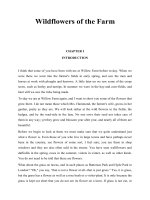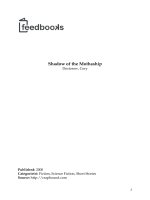The Female Brain is one of the most-talked-about books of the year. ppt
Bạn đang xem bản rút gọn của tài liệu. Xem và tải ngay bản đầy đủ của tài liệu tại đây (1.02 MB, 302 trang )
T he F emale B rain
is one of the most-talked-about books of the year.
“I’ve found I can change the conversation at any social gathering by
mentioning Louann Brizendine’s book, The Female Brain.”
—David Brooks, New York Times
“Feminists should celebrate: Finally someone is taking women’s health
seriously and has done a thorough study of the female brain
. . . . Yet
undoubtedly this book will make feminists vested in denying sex dif
-
ferences uncomfortable.”
—Washington Times
“The author’s greatest gift to her readers is the way she takes us
through the stages of a woman’s life to show the influence of hor
-
mone levels on every decision.”
—Los Angeles Times
“[Brizendine] seamlessly weaves together the findings of innumer-
able articles and books, both technical and popular, along with
accounts of patients she treated at her clinic. . . . Given the character—
and rancor—of our dichotomous approach to the influences of
biology and culture, readers likely will be fascinated or angered, con
-
vinced or skeptical, according to the positions they have staked out
already.”
—Deborah Tannen, Washington Post
“Her conclusions will seem like common sense to some and nothing
short of heresy to others. . . . Her ideas are certain to spark contro-
versy from some doctors and social scientists who think books like
this undercut women and reinforce old gender stereotypes.”
—Newsweek
“Brizendine calls The Female Brain an ‘owner’s manual’ for women, but
it’s worth a look for men, too—even though we’re hardwired not to
read the instructions.”
—Toronto Sun
“Part road map for women looking for scientific explanations for their
behavior, part geeky manual for relationship woes . . . Brizendine is
at her best when describing the neurochemical underpinnings of pas
-
sionate love.”
—San Francisco Chronicle
“A wonderful new book . . . Brizendine’s book shares how women’s
brains and hormones cause us to value different things during differ
-
ent stages of our lives, which can affect everything from career deci-
sions to who we fall in love with.”
—Gannett News Service
“It’s bloody brilliant. . . . It’s answered not only the questions that have
plagued me for years, but it’s answered questions I hadn’t even for
-
mulated yet. I am so not kidding. . . . I’m just glad to have a book that
is not only fascinating, it makes me feel less insane.”
—The Huffington Post
“Brizendine lays out the key stages of life in eight juicy chapters,
solidly useful wherever you are on her timeline. I wish I’d been able
to read ‘Why the Teen Girl Brain Freaks’ at puberty. Of course,
knowledge is power . . .”
—Bust magazine
“A trove of information, as well as some stunning insights . . . While
this book will be of interest to anyone who wonders why men and
women are so different, it will be particularly useful for women and
parents of girls.”
—Publishers Weekly
“This book should be required reading for all women, and it wouldn’t
hurt for men to give it a glance as well.”
—Pilot (North Carolina)
“Brizendine is onto something. . . . This is going to be a bumpy ride.”
—William Booth, Washington Post
The Female B
B B
N ew Y ork
rain
r o a d way o oks
Louann Brizendine, M.D.
published by broadway books
Copyright © 2006 by Louann Brizendine
All Rights Reserved
A hardcover edition of this book was originally published
in 2006 by Morgan Road Books.
Published in the United States by Broadway Books,
an imprint of The Doubleday Broadway Publishing Group,
a division of Random House, Inc., New York.
www.broadwaybooks.com
broadway books and its logo, a letter B bisected on the diagonal,
are registered trademarks of Random House, Inc.
This book is not intended to take the place of medical advice from a trained med-
ical professional. Readers are advised to consult a physician or other qualified
health professional regarding treatment of their medical problems. Neither the
publisher nor the author takes any responsibility for any possible consequences
from any treatment, action, or application of medicine, herb, or preparation to
any person reading or following the information in this book.
Book design by Pauline Neuwirth, Neuwirth & Associates, Inc.
Library of Congress Cataloging-in-Publication Data
Brizendine, Louann, 1952–
The female brain / Louann Brizendine.
p. cm.
1. Brain—Physiology. 2. Brain—Psychology. 3. Women. I. Title.
QP376.B755 2006
612.8—dc22
2006040765
eISBN: 978-0-7679-2841-0
v1.0
For my husband,
Samuel Barondes,
My son,
John Whitney Brizendine,
And in loving memory of
Louise Ann Brizendine
CONTENTS
INTRODUCTION:
What Makes Us Women 1
ONE
The Birth of the Female Brain 11
TWO
Teen Girl Brain 31
THREE
Love and Trust 57
FOUR
Sex: The Brain Below the Belt 77
FIVE
The Mommy Brain 95
SIX
Emotion: The Feeling Brain 117
SEVEN
The Mature Female Brain 135
EPILOGUE
The Future of the Female Brain 159
vii
C ontents
APPENDIX ONE:
The Female Brain and Hormone Therapy 165
APPENDIX TWO:
The Female Brain and Postpartum Depression 181
APPENDIX THREE:
The Female Brain and Sexual Orientation 185
NOTES
189
REFERENCES
211
INDEX
271
viii
A CKNO WLEDGMENTS
This book had its beginnings during my educational years at the
University of California, Berkeley; Yale; Harvard; and University Col
-
lege, London, so I would like to thank the teachers and fellow students
who most influenced my thinking during those years: Frank Beach,
Mina Bissel, Henry Black, Bill Bynum, Dennis Charney, Marion Dia
-
mond, Marilyn Farquar, Carol Gilligan, Paul Greengard, Tom Guteil,
Les Havens, Florence Haseltine, Marjorie Hayes, Peter Hornick, Stan
-
ley Jackson, Valerie Jacoby, Kathleen Kells, Kathy Kelly, Adrienne
Larkin, Howard Levitin, Mel Lewis, Charlotte McKenzie, David Mann,
Daniel Mazia, William Meissner, Jonathan Muller, Fred Naftolin,
George Palade, Roy Porter, Sherry Ryan, Carl Salzman, Leon Shapiro,
Rick Shelton, Gunter Stent, Frank Thomas, Janet Thompson, George
Vaillant, Roger Wallace, Clyde Willson, Fred Wilt, and Richard Woll
-
heim.
During my years on the faculty at Harvard and the University of
California, San Francisco, my thinking has been influenced by Bruce
Ames, Cori Bargmann, Regina Casper, Francis Crick, Mary Dallman,
Herb Goldings, Deborah Grady, Joel Kramer, Fernand Labrie, Jeanne
Leventhal, Sindy Mellon, Michael Merzenich, Joseph Morales, Eu
-
gene Roberts, Laurel Samuels, Carla Shatz, Stephen Stahl, Elaine
Storm, Marc Tessier-Lavigne, Rebecca Turner, Victor Viau, Owen
Wolkowitz, and Chuck Yingling.
My colleagues, staff, residents, medical students, and patients in the
Women’s and Teen Girls’ Mood and Hormone Clinic have contributed
in many ways to this work: Denise Albert, Raya Almufti, Amy Berlin,
ix
A cknowledgments
Cathy Christensen, Karen Cliffe, Allison Doupe, Judy Eastwood,
Louise Forrest, Adrienne Fratini, Lyn Gracie, Marcie Hall-Mennes,
Steve Hamilton, Caitlin Hasser, Dannah Hirsch, Susie Hobbins, Fa
-
tima Imara, Lori Lavinthal, Karen Leo, Shana Levy, Katherine Mal-
ouh, Faina Nosolovo, Sarah Prolifet, Jeanne St. Pierre, Veronica Saleh,
Sharon Smart, Alla Spivak, Elizabeth Springer, Claire Wilcox, and
Emily Wood.
I also thank my other colleagues, students, and staff at Langley
Porter Psychiatric Institute and UCSF whose contributions I have ap
-
preciated: Alison Adcock, Regina Armas, Jim Asp, Renee Binder,
Kathryn Bishop, Mike Bishop, Alla Borik, Carol Brodsky, Marie Caf-
fey, Lin Cerles, Robin Cooper, Haile Debas, Andrea DiRocchi, Glenn
Elliott, Stu Eisendrath, Leon Epstein, Laura Esserman, Ellen Haller,
Dixie Horning, Marc Jacobs, Nancy Kaltreider, David Kessler,
Michael Kirsch, Laurel Koepernick, Rick Lannon, Bev Lehr, Descartes
Li, Jonathan Lichtmacher, Elaine Cooper Lonnergan, Alan Louie,
Theresa McGinness, Robert Malenka, Charlie Marmar, Miriam Mar
-
tinez, Craig Nelson, Kim Norman, Chad Peterson, Anne Poirier,
Astrid Prackatzch, Victor Reus, John Rubenstein, Bryna Segal, Lynn
Shroeder, John Sikorski, Susan Smiga, Anna Spielvogel, David Taylor,
Larry Tecott, Renee Valdez, Craig Van Dyke, Mark Van Zastrow,
Susan Voglmaier, John Young, and Leonard Zegans.
I am very grateful to those who have read and critiqued drafts of
this book: Carolyn Balkenhol, Marcia Barinaga, Elizabeth Barondes,
Diana Brizendine, Sue Carter, Sarah Cheyette, Diane Cirrincione,
Theresa Crivello, Jennifer Cummings, Pat Dodson, Janet Durant, Jay
Giedd, Mel Grumbach, Dannah Hirsch, Sarah Hrdy, Cynthia Kenyon,
Adrienne Larkin, Jude Lange, Jim Leckman, Louisa Llanes, Rachel
Llanes, Eleanor Maccoby, Judith Martin, Diane Middlebrook, Nancy
Milliken, Cathy Olney, Linda Pastan, Liz Perle, Lisa Queen, Rachel
Rokicki, Dana Slatkin, Millicent Tomkins, and Myrna Weissman.
The work presented here has particularly benefited from the re-
search, writings, and advice of Marty Altemus, Arthur Aron, Simon
x
A cknowledgments
Baron-Cohen, Jill Becker, Andreas Bartels, Lucy Brown, David Buss,
Larry Cahill, Anne Campbell, Sue Carter, Lee Cohen, Susan Davis,
Helen Fisher, Jay Giedd, Jill Goldstein, Mel Grumbach, Andy Guay,
Melissa Hines, Nancy Hopkins, Sarah Hrdy, Tom Insel, Bob Jaffe,
Martha McClintock, Erin McClure, Eleanor Maccoby, Bruce McEwen,
Michael Meaney, Barbara Parry, Don Pfaff, Cathy Roca, David Rubi
-
now, Robert Sapolsky, Peter Schmidt, Nirao Shah, Barbara Sherwin,
Elizabeth Spelke, Shelley Taylor, Kristin Uvnäs-Moberg, Sandra Wi-
telson, Sam Yen, Kimberly Yonkers, and Elizabeth Young.
I also thank supporters with whom I have had lively and influential
conversations over the past few years about the female brain: Bruce
Ames, Giovanna Ames, Elizabeth Barondes, Jessica Barondes, Lynne
Krilich Benioff, Marc Benioff, ReVeta Bowers, Larry Ellison, Melanie
Craft Ellison, Cathy Fink, Steve Fink, Milton Friedman, Hope Frye,
Donna Furth, Alan Goldberg, Andy Grove, Eva Grove, Anne Hoops,
Jerry Jampolsky, Laurene Powell Jobs, Tom Kornberg, Josh Leder
-
berg, Marguerite Lederberg, Deborah Leff, Sharon Agopian Melodia,
Shannon O’Rourke, Judy Rapoport, Jeanne Robertson, Sandy Robert
-
son, Joan Ryan, Dagmar Searle, John Searle, Garen Staglin, Shari
Staglin, Millicent Tomkins, Jim Watson, Meredith White, Barbara
Willenborg, Marilyn Yalom, and Jody Kornberg Yeary.
I would also like to thank the individuals and private foundations
that have supported my work: Lynne and Marc Benioff, Larry Elli
-
son, the Lawrence Ellison Medical Foundation, National Center for
Excellence in Women’s Health at UCSF, the Osher Foundation, the
Salesforce.com Foundation, the Staglin Family Music Festival for
Mental Health, the Stanley Foundation, and the UCSF Department of
Psychiatry.
This book was initially developed through the skill and talent of
Susan Wels, who helped me write the first draft and organize vast
amounts of material. I owe her the greatest debt of gratitude.
I am very thankful to Liz Perle, who first persuaded me to write
this book, and to the others who believed in it and worked hard to make
xi
A cknowledgments
it happen: Susan Brown, Rachel Lehmann-Haupt, Deborah Chiel,
Marc Haeringer, and Rachel Rokicki. My agent, Lisa Queen of Queen
Literary, has been a terrific supporter and has made many brilliant
suggestions throughout this process.
I am especially grateful to Amy Hertz, vice president and publisher
of Morgan Road Books, who had a vision for this project from the be
-
ginning and kept demanding excellence and crafting revisions to cre-
ate a narrative in which the science comes alive.
I also want to thank my son, Whitney, who tolerated this long and
demanding project with grace and made important contributions to
the teen chapter.
Most of all I thank my husband and soul mate, Sam Barondes, for
his wisdom, endless patience, editorial advice, scientific insight, love,
and support.
xii
1. Anterior C C
2. P C
3. I
women.
4. H
5. A
6. P G
7. H
The Female B
ingulate ortex (ACC): Weighs options, makes decisions.
It’s the worry-wort center, and it’s larger in women than in men.
refrontal ortex (PFC): The queen that rules the emotions and
keeps them from going wild. It puts the brakes on the amygdala. Larger in
women, and matures faster in teen girls than in boys by one to two years.
nsula: The center that processes gut feelings. Larger and more active in
ypothalamus: The conductor of the hormonal symphony; kicks the go-
nads into gear. Starts pumping earlier at puberty in females.
mygdala: The wild beast within; the instinctual core, tamed only by the
PFC. Larger in men.
ituitary land: Produces hormones of fertility, milk production, and
nurturing behavior. Helps turn on the mommy brain.
ippocampus: The elephant that never forgets a fight, a romantic en-
counter, or a tender moment—and won’t let you forget it, either. Larger
and more active in women.
rain
THE CAST OF
NEUR O-HORMONE CHARA CTERS
(in other words, how hormones affect a woman’s brain)
The ones your doctor knows about
Estrogen—the queen: powerful, in control, all-consuming; some-
times all business, sometimes an aggressive seductress; friend of
dopamine, serotonin, oxytocin, acetylcholine, and norepinephrine
(the feel-good brain chemicals).
Progesterone—in the background but a powerful sister to es-
trogen; intermittently appears and sometimes is a storm cloud re-
versing the effects of estrogen; other times is a mellowing agent;
mother of allopregnenolone (the brain’s Valium, i.e., chill pill).
Testosterone—fast, assertive, focused, all-consuming, mascu-
line; forceful seducer; aggressive, unfeeling; has no time for cud-
dling.
The ones your doctor may not know about that also affect a woman’s
brain
Oxytocin—fluffy, purring kitty; cuddly, nurturing, earth mother;
the good witch Glinda in The Wizard of Oz; finds pleasure in help
-
ing and serving; sister to vasopressin (the male socializing hor-
mone), sister to estrogen, friend of dopamine (another feel-good
brain chemical).
xv
The C ast of Neuro-Hormone C haracters
Cortisol—frizzled, frazzled, stressed out; highly sensitive,
physically and emotionally.
Vasopressin—secretive, in the background, subtle aggressive
male energies; brother to testosterone, brother to oxytocin (makes
you want to connect in an active, male way, as does oxytocin).
DHEA—reservoir of all the hormones; omnipresent, pervasive,
sustaining mist of life; energizing; father and mother of testos
-
terone and estrogen, nicknamed “the mother hormone,” the Zeus
and Hera of hormones; robustly present in youth, wanes to nothing
in old age.
Androstenedione—the mother of testosterone in the ovaries;
supply of sassiness; high-spirited in youth, wanes at menopause,
dies with the ovaries.
Allopregnenolone—the luxurious, soothing, mellowing
daughter of progesterone; without her, we are crabby; she is sedat
-
ing, calming, easing; neutralizes any stress, but as soon as she
leaves, all is irritable withdrawal; her sudden departure is the cen
-
tral story of PMS, the three or four days before a woman’s period
starts.
xvi
PHASES OF
A FEMALE’S LIFE
Hormones can determine what the brain is interested in doing.
They help guide nurturing, social, sexual, and aggressive behaviors.
They can affect being talkative, being flirtatious, giving or attending
parties, writing thank-you notes, planning children’s play dates, cud
-
dling, grooming, worrying about hurting the feelings of others, being
competitive, masturbating and initiating sex.
xvii
Phases of a Female’ s L ife
Major Hormone W Females H
Changes T Males Don’t
F
G
P
S
P
Breast feeding
Child rearing
P
M
P
testosterone increase and
Oxytocin, prolactin
testosterone
testosterone
female-specific circuits
choosing a career or job
petition
More calmness
hat ave
hat
etal
irlhood
uberty
exual
maturity,
single woman
regnancy
erimenopause
enopause
ostmenopause
Brain growth and develop-
ment left unperturbed by the
high testosterone that makes
a male brain
Estrogen is secreted in mas-
sive amounts from age 1 to
24 months, then the juvenile
pause turns off hormones
Estrogen, progesterone, and
begin to cycle monthly
Estrogen, progesterone, and
testosterone change every
day of the month
Huge increases in proges-
terone, estrogen
Oxytocin; cycling estro-
gen, progesterone, and
Erratically cycling estro-
gen, progesterone, and
Low estrogen and no
progesterone; high FSH/LH
Low, steady estrogen and
testosterone; lower oxytocin
Brain cells are XX, which
means more genes for faster
brain development and
High estrogen for up to 2
years after birth
More estrogen and less
testosterone; girls’ brains
develop 2 years earlier than
boys’
More focus on relationships,
finding a lifelong mate, and
compatible with raising a
family
Focus more on nesting, how
the family will be provided
for; less on career and com-
Focus more exclusively on
the baby
Less interest in sex, more
worry about kids
Fluctuating interest in
sex, erratic sleep, more
fatigue, worry, moods, hot
flashes, and irritability
The last precipitous brain
change caused by hormones
xviii
Phases of a Female’ s Life
male around to kill all those cells
enhanced
and emotional control circuits
emotional bonding
emotional
Female-S Brain Changes R Change
parents
ing with increased stress and work
you want
to do; less interest in taking care of
Female brain circuits for communica-
tion, gut feelings, emotional memory,
and anger suppression grow unabated—
there is no high testosterone of the
Verbal and emotional circuits are
Increased sensitivity and growth of
stress, verbal, emotion, and sex circuits
Earlier maturation of decision-making
Stress circuits suppressed; brain
calmed by progesterone; brain shrinks;
hormones from the fetus and placenta
take over brain and body
Stress circuits still suppressed; sex and
emotion circuits hijacked by infant care
Increased function of brain circuits for
maternal aggression, stress, worry, and
Decreasing sensitivity to estrogen in
certain brain circuits
Circuits fueled by estrogen, oxytocin,
and progesterone decline
Circuits less reactive to stress, less
pecific eality
More brain circuits for communication,
reading emotions, social nuance, nur-
turing skills; able to use both sides of
the brain
Major interest in playing and having
fun in connection with other girls,
not boys
Major interest is sexual attractiveness,
desperate love interests, avoidance of
Major interests in finding a mate, love,
career development
Major interest in physical well-being,
coping with fatigue, nausea, and
hunger, and not damaging the fetus;
surviving in the workplace; and plan-
ning maternity leave
Major focus on coping with fatigue,
sore nipples, breast milk production,
making it through the next 24 hours
Major interest in well-being, develop-
ment, education, and safety of kids; cop-
Major interest is surviving day to day
and coping with the physical and emo-
tional ups and downs
Major interest in staying healthy,
improving well-being and embracing
new challenges
Major interest in doing what
others
xix
The Female Brain
INTR ODUCTION
What Makes Us Women
M
ore than 99 percent of male and female genetic coding is ex-
actly the same. Out of the thirty thousand genes in the human
genome, the less than one percent variation between the sexes is
small. But that percentage difference influences every single cell in our
bodies—from the nerves that register pleasure and pain to the neu
-
rons that transmit perception, thoughts, feelings, and emotions.
To the observing eye, the brains of females and males are not the
same. Male brains are larger by about 9 percent, even after correcting
for body size. In the nineteenth century, scientists took this to mean
that women had less mental capacity than men. Women and men, how
-
ever, have the same number of brain cells. The cells are just packed
more densely in women—cinched corsetlike into a smaller skull.
For much of the twentieth century, most scientists assumed that
women were essentially small men, neurologically and in every other
sense except for their reproductive functions. That assumption has been
at the heart of enduring misunderstandings about female psychology
1
T he F emale B rain
and physiology. When you look a little deeper into the brain differ-
ences, they reveal what makes women women and men men.
Until the 1990s, researchers paid little attention to female physiol-
ogy, neuroanatomy, or psychology separate from that of men. I saw
this oversight firsthand during my undergraduate years in neurobiol
-
ogy at Berkeley in the 1970s, during my medical education at Yale, and
during my training in psychiatry at the Massachusetts Mental Health
Center at Harvard Medical School. While enrolled at each of these in
-
stitutions, I learned little or nothing about female biological or neuro-
logical difference outside of pregnancy. When a professor presented a
study about animal behavior one day at Yale, I raised my hand and
asked what the research findings were for females in that study. The
male professor dismissed my question, stating, “We never use females
in these studies—their menstrual cycles would just mess up the data.”
The little research that was available, however, suggested that the
brain differences, though subtle, were profound. As a resident in psy
-
chiatry, I became fascinated by the fact that there was a two-to-one ra-
tio of depression in women compared with men. No one was offering
any clear reasons for this discrepancy. Because I had gone to college
at the peak of the feminist movement, my personal explanations ran
toward the political and the psychological. I took the typical 1970s
stance that the patriarchy of Western culture must have been the cul
-
prit. It must have kept women down and made them less functional
than men. But that explanation alone didn’t seem to fit: new studies
were uncovering the same depression ratio worldwide. I started to
think that something bigger, more basic and biological, was going on.
One day it struck me that male versus female depression rates
didn’t start to diverge until females turned twelve or thirteen—the
age girls began menstruating. It appeared that the chemical changes
at puberty did something in the brain to trigger more depression in
women. Few scientists at the time were researching this link, and most
psychiatrists, like me, had been trained in traditional psychoanalytic
theory, which examined childhood experience but never considered
that specific female brain chemistry might be involved. When I started
2









